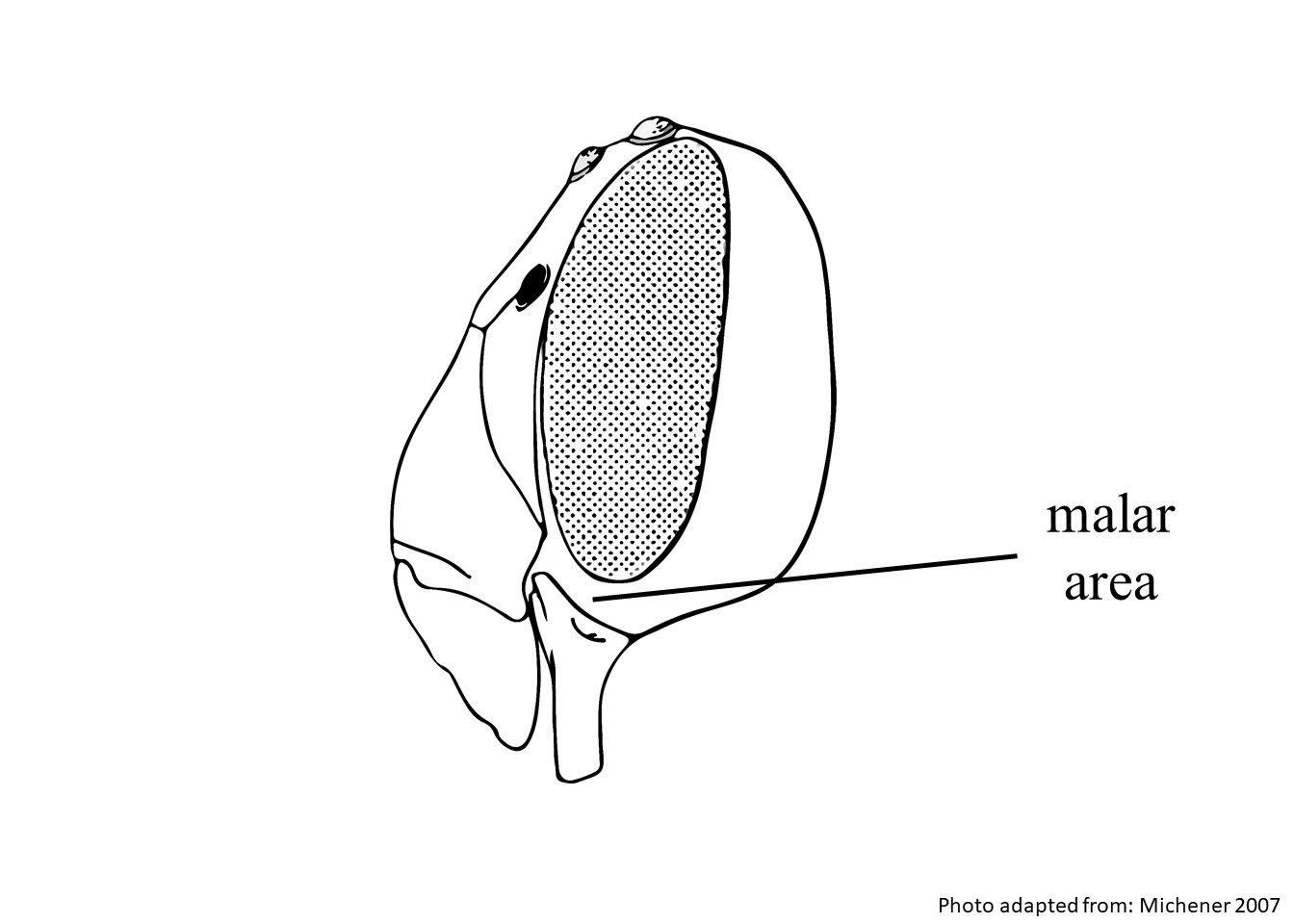Family: Megachilidae
Subfamily: Megachilinae
Tribe: Osmiini
Genus: Osmia Panzer, 1806
Subgenus: O. (Osmia) Panzer, 1806
Species: Osmia emarginata Lepeletier, 1841
Common name: none
Osmia (Osmia) emarginata are black bees, sometimes with a metallic blue shimmer to the body (Amiet et al. 2004Amiet et al. 2004:
Amiet, F., M. Herrmann, A. Mueller, and R. Neumeyer. 2004. Apidae 4: Anthidium , Chelostoma , Coelioxys , Dioxys , Heriades , Lithurgus , Megachile , Osmia , Stelis . Fauna Helvetica 9: 1ndash;273.). Females have intermixed black and pale hairs on the face, yellow-white hair on the thorax, pale hair on T1–T3, both black and pale hair on T4T4:
the segments on the top side of the abdomen, often abbreviated when referring to a specific segment to T1, T2, T3, T4, T5, T6, or T7 , and primarily black hair on T5–T6. Male hair coloration is similar to the females except for the head, which is primarily white on the face and often has intermixed black and white hairs on the vertexvertex:
, and primarily black hair on T5–T6. Male hair coloration is similar to the females except for the head, which is primarily white on the face and often has intermixed black and white hairs on the vertexvertex:
the area between the ocelli and the back of the head. Female body length is 13–15 mm, and male body length is 10–12 mm (Banaszak and Romasenko 1998Banaszak and Romasenko 1998:
Banaszak, J. and L. Romasenko. 1998. Megachilid bees of Europe (Hymenoptera, Apoidea, Megachilidae). Bydgoszcz University, Bydgoszcz, Poland.).
(modified from Peters 1978Peters 1978:
Peters, D.S. 1978. Systematik und Zoogeographie der west-palauml;arktischen Arten von Osmia Panzer, 1806 s. str., Monosmia Tkalcu, 1974 und Orientosmia n. subgen. (Insecta: Hymenoptera: Megachilidae). Senckenbergiana Biologica (Frankfurt) 58: 287ndash;346.; Banaszak and Romasenko 1998Banaszak and Romasenko 1998:
Banaszak, J. and L. Romasenko. 1998. Megachilid bees of Europe (Hymenoptera, Apoidea, Megachilidae). Bydgoszcz University, Bydgoszcz, Poland.)
 without apicalapical:
without apicalapical: .
. without gradulusgradulus:
without gradulusgradulus:Osmia emarginata is similar enough to O. mustelina that it could possibly be considered a subspecies of O. mustelina (Peters 1978Peters 1978:
Peters, D.S. 1978. Systematik und Zoogeographie der west-palauml;arktischen Arten von Osmia Panzer, 1806 s. str., Monosmia Tkalcu, 1974 und Orientosmia n. subgen. (Insecta: Hymenoptera: Megachilidae). Senckenbergiana Biologica (Frankfurt) 58: 287ndash;346.). Females can be more easily distinguished by the shape of the apicalapical:
near or at the apex or end of any structure
margin of the clypeusclypeus:
a section of the face below the antennae, demarcated by the epistomal sutures and the absence of an impunctateimpunctate:
marked with punctures or pits
median ridge on the discdisc:
a generic term for the middle surface of a plate (usually in reference to an abdominal segment)
of the clypeusclypeus:
a section of the face below the antennae, demarcated by the epistomal sutures (Banaszak and Romasenko 1998Banaszak and Romasenko 1998:
Banaszak, J. and L. Romasenko. 1998. Megachilid bees of Europe (Hymenoptera, Apoidea, Megachilidae). Bydgoszcz University, Bydgoszcz, Poland.). Males are more difficult to distinguish; in general O. emarginata has fuller, reddish-brown hair on the thorax, the gonocoxitegonocoxite:
basal part of the appendage formed on each side of the male genitalia. It can be partly or completely fused to the gonostylus at the apical portion of the appendage, often making the two segments indistinguishable.
is almost right-angled subapically, and the ventralventral:
of, on, or relating to the underside of an animal, or segment of an animal
ridge is more apparent (Peters 1978Peters 1978:
Peters, D.S. 1978. Systematik und Zoogeographie der west-palauml;arktischen Arten von Osmia Panzer, 1806 s. str., Monosmia Tkalcu, 1974 und Orientosmia n. subgen. (Insecta: Hymenoptera: Megachilidae). Senckenbergiana Biologica (Frankfurt) 58: 287ndash;346.).
Osmia emarginata adults have been recorded in flight from May to July (Banaszak and Romasenko 1998Banaszak and Romasenko 1998:
Banaszak, J. and L. Romasenko. 1998. Megachilid bees of Europe (Hymenoptera, Apoidea, Megachilidae). Bydgoszcz University, Bydgoszcz, Poland.).
Osmia emarginata are polylecticpolylectic:
bees that collect pollen from the flowers of a variety of unrelated plants
and have been associated with Fabaceae, Boraginaceae, Cistaceae, Scabiosa (Caprifoliaceae), and Ajuga (Lamiaceae) (Amiet et al. 2004Amiet et al. 2004:
Amiet, F., M. Herrmann, A. Mueller, and R. Neumeyer. 2004. Apidae 4: Anthidium , Chelostoma , Coelioxys , Dioxys , Heriades , Lithurgus , Megachile , Osmia , Stelis . Fauna Helvetica 9: 1ndash;273.).
Osmia emarginata are known to nest in fissures between stones and cavities in rock, more often in broad cavities than narrow ones (Banaszak and Romasenko 1998Banaszak and Romasenko 1998:
Banaszak, J. and L. Romasenko. 1998. Megachilid bees of Europe (Hymenoptera, Apoidea, Megachilidae). Bydgoszcz University, Bydgoszcz, Poland.). Nest cells are arranged in an irregular, clump-like shape (Banaszak and Romasenko, 1998). Nest cells are composed from chewed leaves (Amiet et al. 2004Amiet et al. 2004:
Amiet, F., M. Herrmann, A. Mueller, and R. Neumeyer. 2004. Apidae 4: Anthidium , Chelostoma , Coelioxys , Dioxys , Heriades , Lithurgus , Megachile , Osmia , Stelis . Fauna Helvetica 9: 1ndash;273.).
Osmia emarginata specimens have been recorded in North Africa and South and Central Europe (Banaszak and Romasenko 1998Banaszak and Romasenko 1998:
Banaszak, J. and L. Romasenko. 1998. Megachilid bees of Europe (Hymenoptera, Apoidea, Megachilidae). Bydgoszcz University, Bydgoszcz, Poland.).
Distribution map generated by Discover Life -- click on map for details, credits, and terms of use.